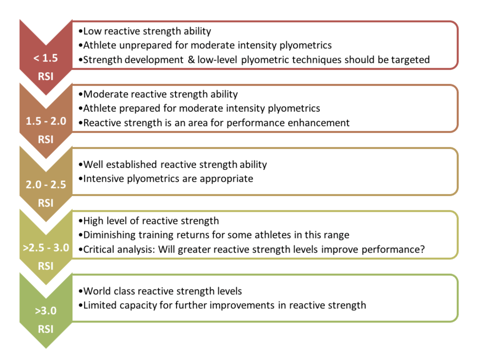RSI stands for Reactive Strength Index.
- RSI is the ratio of Flight Time & Ground Contact Time
- RSI = Flight Time / Ground Contact Time
- Time To Take-Off (TTT) can be substituted for Ground Contact Time if the movement being performed is a Countermovement Jump.
- There is no unit for RSI.
mRSI stands for Modified Reactive Strength Index.
- mRSI is the ratio of Jump Height & Ground Contact Time
- mRSI = Jump Height / Ground Contact Time
- Time To Take-Off (TTT) can be substituted for Ground Contact Time if the movement being performed is a Countermovement Jump.
- There is no unit for mRSI.
Practical Application
- RSI and mRSI are typically used as a way to measure an athlete's reactive strength ability. These metrics helps answer the questions...
- How elastic is this athlete?
- How effectively do they use their stretch-shortening cycle?
- Do we need to work on this quality?
- Assessments of reactive strength include...
- Fast Explosive Strength: drop jump, countermovement rebound jump, and multi rebound jump.
- Slow Explosive Strength: countermovement jump
- What is a good mRSI value?
- This figure below shows RSI on the righthand sign, however Eamonn is using the equation Jump Height / Contact Time. These values are best used when analyzing mRSI during a drop jump off of a 30cm box.

This figure above is an except from the Train With Push blog post titled 'THE REACTIVE STRENGTH INDEX REVISITED - PART 2 BY EAMONN FLANAGAN'
- This figure below shows RSI on the righthand sign, however Eamonn is using the equation Jump Height / Contact Time. These values are best used when analyzing mRSI during a drop jump off of a 30cm box.
- Learn more about Reactive Strength Assessment in our blog here.
- Want to learn more about how to program for athlete's based off of their Reactive Strength values? Take advantage of our Sport Science Consulting Packages. Email us at info@hawkindynamics.com to learn more.
If additional help is needed, please contact techsupport@hawkindynamics.com
-2.png?height=120&name=Hawkin%20Logo%20(2)-2.png)